MERCEDES-BENZ METRIS 2016 MY16 Operator’s Manual
Manufacturer: MERCEDES-BENZ, Model Year: 2016, Model line: METRIS, Model: MERCEDES-BENZ METRIS 2016Pages: 310, PDF Size: 7.28 MB
Page 81 of 310
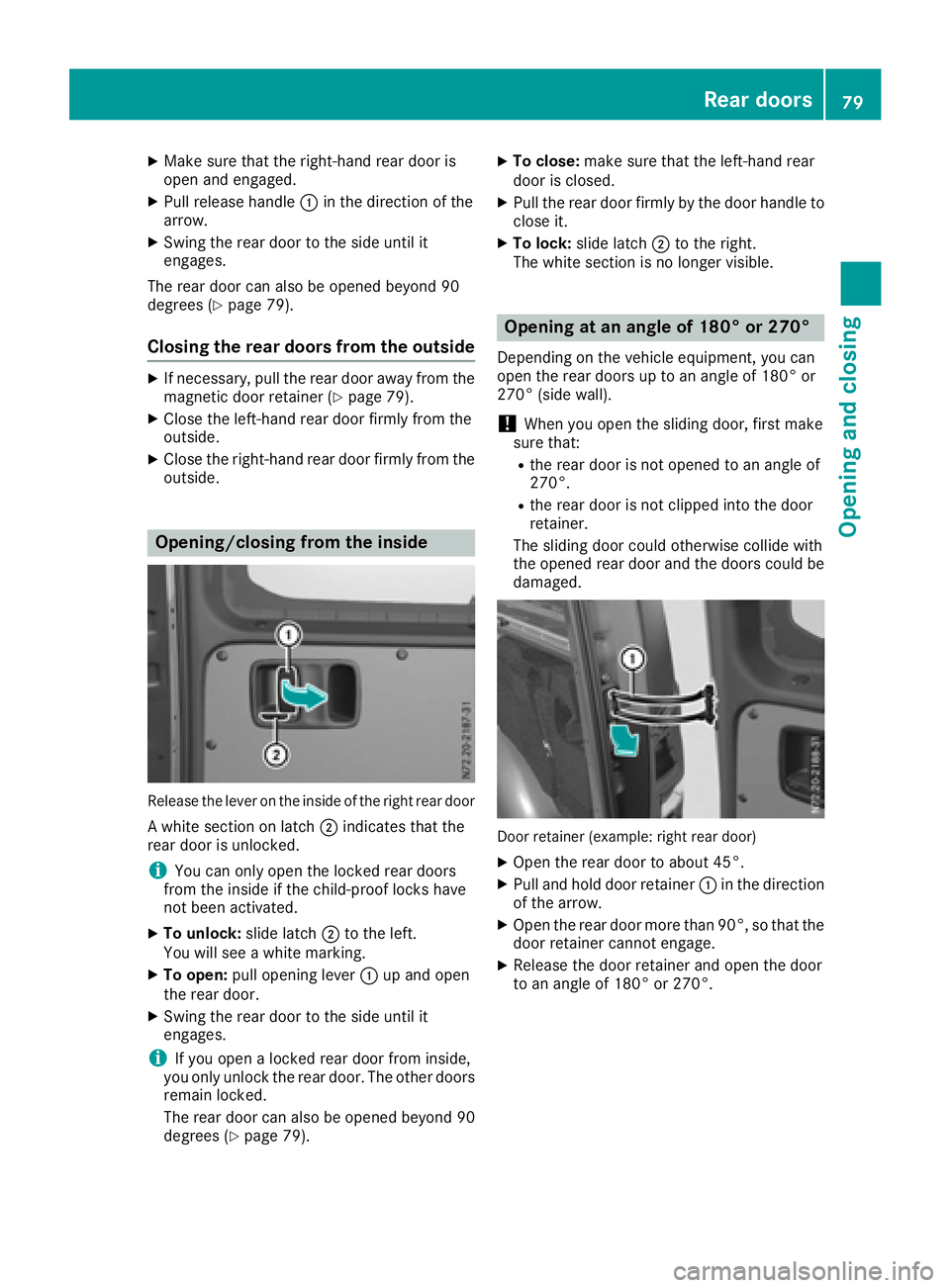
XMake sure that the right-hand rear door is
open and engaged.
XPull release handle:in the direction of the
arrow.
XSwing the rear door to the side until it
engages.
The rear door can also be opened beyond 90
degrees (
Ypage 79).
Closing the rear doors from the outside
XIf necessary, pull the rear door away from the
magnetic door retainer (Ypage 79).
XClose the left-hand rear door firmly from the
outside.
XClose the right-hand rear door firmly from the outside.
Opening/closing from the inside
Release the lever on the inside of the right rear door
Aw hite section on latch ;indicates that the
rear door is unlocked.
iYou can only open the locked rear doors
from the inside if the child-proof locks have
not been activated.
XTo unlock: slide latch;to the left.
You will see awhite marking.
XTo open: pull opening lever :up and open
the rear door.
XSwing the rear door to the side until it
engages.
iIf you open alocked rear door from inside,
you only unlock the rear door. The other doors
remain locked.
The rear door can also be opened beyond 90
degrees (
Ypage 79).
XTo close: make sure that the left-hand rear
door is closed.
XPull the rear door firmly by the door handle to
close it.
XTo lock: slide latch ;to the right.
The white section is no longer visible.
Opening at an angle of 180° or 270°
Depending on the vehicle equipment, you can
open the rear doors up to an angle of 180° or
270° (side wall).
!When you open the sliding door, first make
sure that:
Rthe rear door is not opened to an angle of
270°.
Rthe rear door is not clipped into the door
retainer.
The sliding door could otherwise collide with
the opened rear door and the doors could be
damaged.
Door retainer (example: right rear door)
XOpen the rear door to about 45°.
XPull and hold door retainer :in the direction
of the arrow.
XOpen the rear door more than 90°, so that the
door retainer cannot engage.
XRelease the door retainer and open the door
to an angle of 180° or 270°.
Rear doors79
Opening and closing
Z
Page 82 of 310
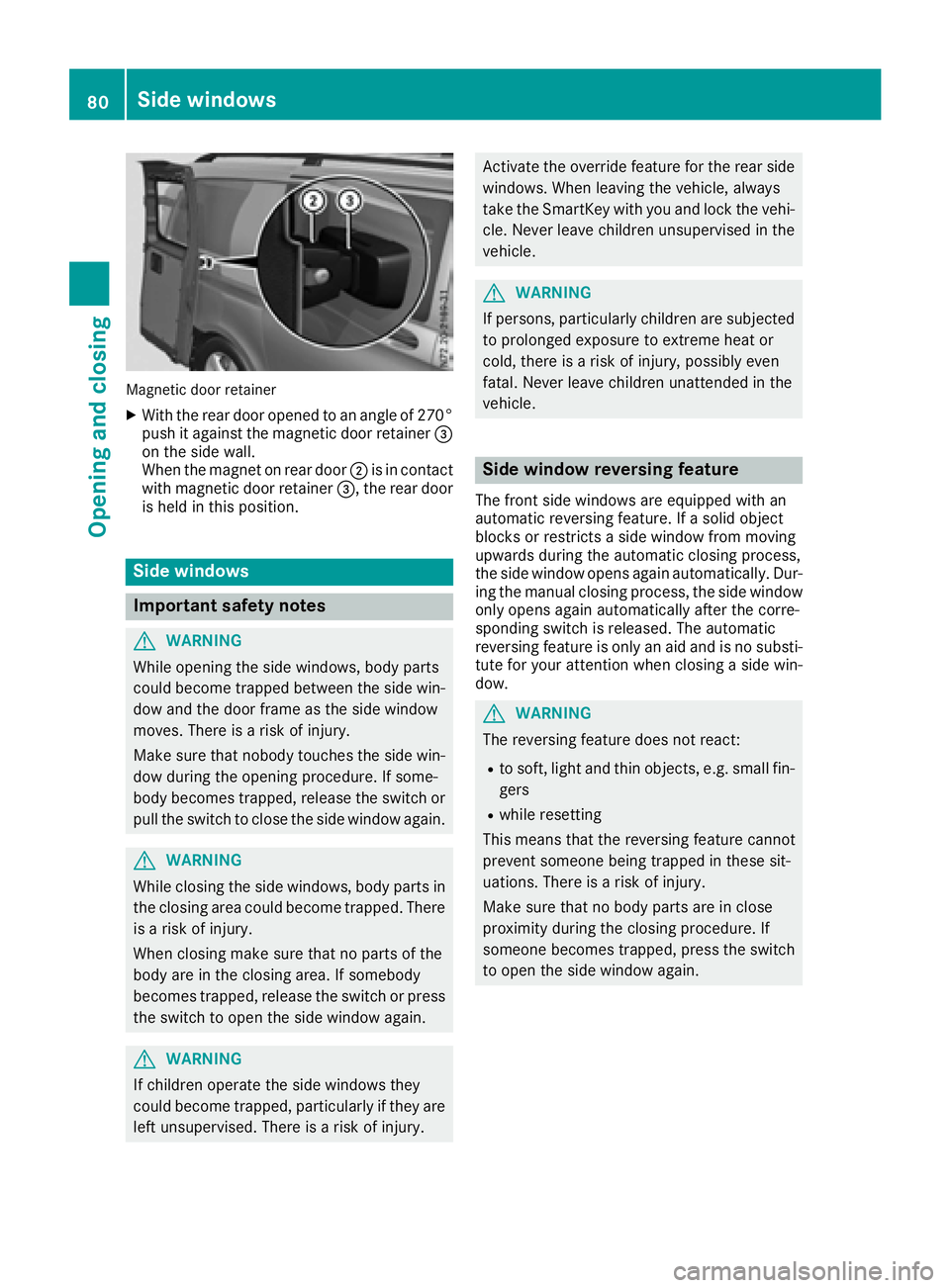
Magnetic door retainer
XWith the rear door opened to an angle of 270°push it against the magnetic door retainer =
on the side wall.
When the magnet on rear door ;is in contact
with magnetic door retainer =,the rear door
is held in this position.
Side windows
Important safety notes
GWARNING
While opening the side windows, body parts
could become trapped between the side win-
dow and the door frame as the side window
moves. There is arisk of injury.
Make sure that nobody touches the side win-
dow during the opening procedure. If some-
body becomes trapped, release the switch or
pull the switch to close the side window again.
GWARNING
While closing the side windows, body parts in
the closing area could become trapped. There is ar isk of injury.
When closing make sure that no parts of the
body are in the closing area. If somebody
becomes trapped, release the switch or press
the switch to open the side window again.
GWARNING
If children operate the side windows they
could become trapped, particularly if they are left unsupervised. There is arisk of injury.
Activate the override feature for the rear side
windows. When leaving the vehicle, always
take the SmartKey with you and lock the vehi-
cle. Never leave children unsupervised in the
vehicle.
GWARNING
If persons, particularly children are subjected to prolonged exposure to extrem eheat or
cold, there is arisk of injury, possibly even
fatal. Never leave children unattended in the
vehicle.
Side window reversing feature
The front side windows are equipped with an
automatic reversing feature. If asolid object
blocks or restrictsas ide window from moving
upwards during the automatic closing process,
the side window opens again automatically .Dur-
ing the manual closing process, the side window
only opens again automatically after the corre-
sponding switch is released. The automatic
reversing feature is only an aid and is no substi-
tute for your attention when closing aside win-
dow.
GWARNING
The reversing feature does not react:
Rto soft, light and thin objects, e.g. small fin-
gers
Rwhile resetting
This means that the reversing feature cannot
prevent someone being trapped in these sit-
uations. There is arisk of injury.
Make sure that no body parts are in close
proximity during the closing procedure. If
someone becomes trapped, press the switch
to open the side window again.
80Side windows
Opening and closing
Page 83 of 310
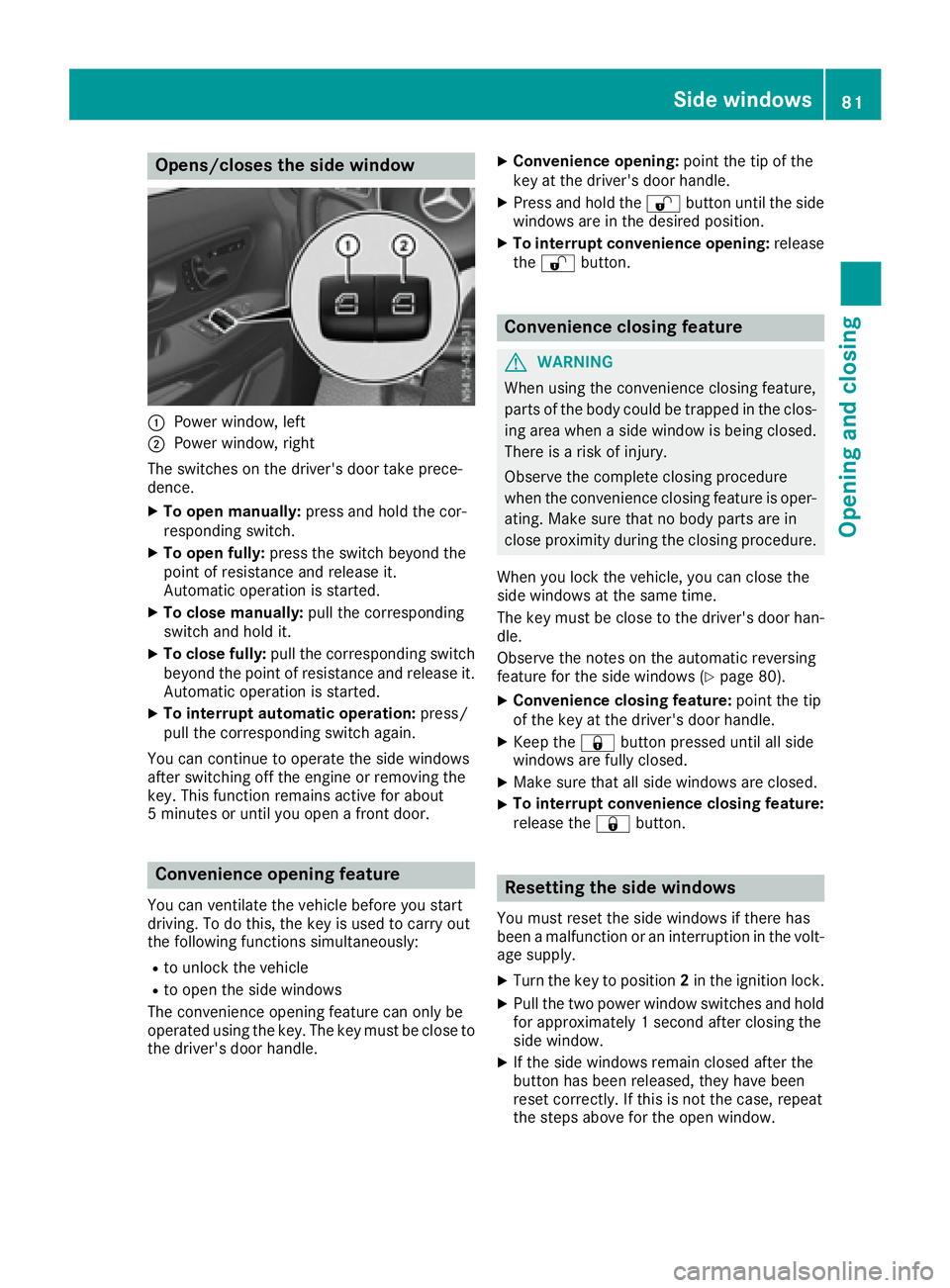
Opens/closes the side window
:Power window, left
;Power window, right
The switches on the driver's door take prece-
dence.
XTo open manually: press and hold the cor-
respondin gswitch.
XTo open fully: press the switch beyond the
point of resistance and release it.
Automatic operation is started.
XTo close manually: pull the corresponding
switch and hold it.
XTo close fully: pull the correspondin gswitch
beyond the point of resistance and release it.
Automatic operation is started.
XTo interrupt automatic operation: press/
pull the correspondin gswitch again.
You can continue to operate the side windows
after switchin goff the engine or removingt he
key. This function remains active for about
5m inutes or until you open afrontd oor.
Convenienceo pening feature
You can ventilate the vehicle before you start
driving. To do this, the key is used to carry out
the following function ssimultaneously:
Rto unlock the vehicle
Rto open the side windows
The convenience opening feature can only be
operated using the key. The key must be close to
the driver's door handle.
XConvenience opening: point the tip of the
key at the driver's door handle.
XPress and hold the %button until the side
windows are in the desired position.
XTo interrupt convenience opening: release
the % button.
Conveniencec losing feature
GWARNING
When using the convenience closing feature,
parts of the body could be trapped in the clos-
ing area when aside window is being closed.
There is arisk of injury.
Observe the completec losing procedure
when the convenience closing feature is oper-
ating. Make sure that no body parts are in
close proximity during the closing procedure.
When you lock the vehicle, you can close the
side windows at the same time.
The key must be close to the driver's door han-
dle.
Observe the notes on the automatic reversing
feature for the side windows (
Ypage 80).
XConvenience closing feature: point the tip
of the key at the driver's door handle.
XKeep the &button pressed until all side
windows are fully closed.
XMake sure that all side windows are closed.
XTo interrupt convenience closing feature:
release the &button.
Resetting the side windows
You must reset the side windows if there has
beenamalfunction or an interruption in the volt-
age supply.
XTurn the key to position 2in the ignition lock.
XPull the two power window switches and hold
for approximately 1seconda fter closing the
side window.
XIf the side windows remain closed after the
button has been released, they have been
reset correctly. If this is not the case, repeat
the steps above for the open window.
Side windows81
Opening and closing
Z
Page 84 of 310
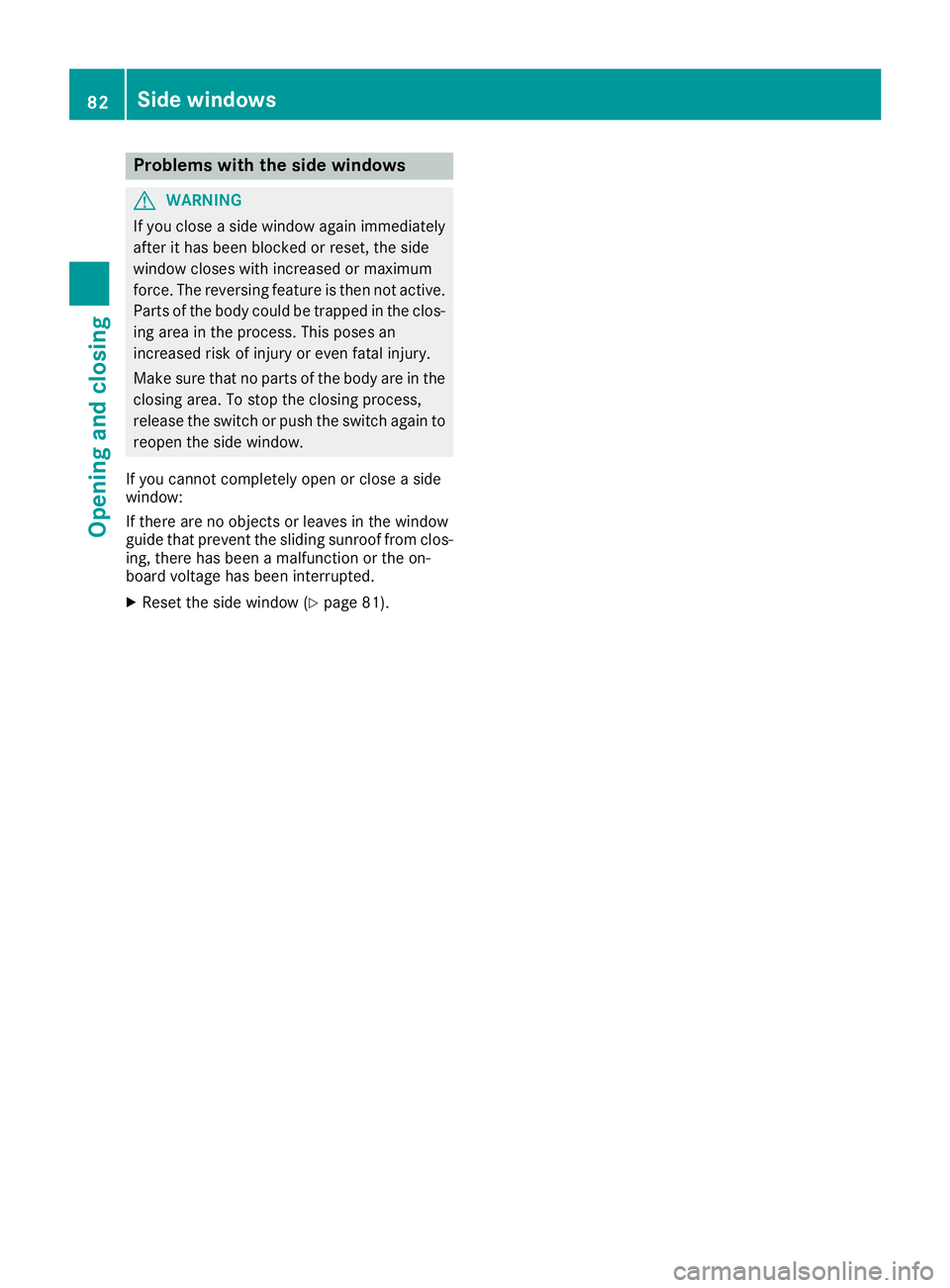
Problems with the side windows
GWARNING
If you close aside window again immediately
after it has been blocked or reset, the side
window closes with increased or maximum
force. The reversing feature is then not active. Parts of the body could be trapped in the clos-
ing area in the process. This poses an
increased risk of injury or even fatal injury.
Make sure that no parts of the body are in the
closing area. To stop the closing process,
release the switch or push the switch again to
reopen the side window.
If you cannot completely open or close aside
window:
If there are no object sorleaves in the window
guide that prevent the sliding sunroof from clos-
ing, there has been amalfunction or the on-
board voltage has been interrupted.
XReset the side window (Ypage 81).
82Side windows
Opening and closing
Page 85 of 310
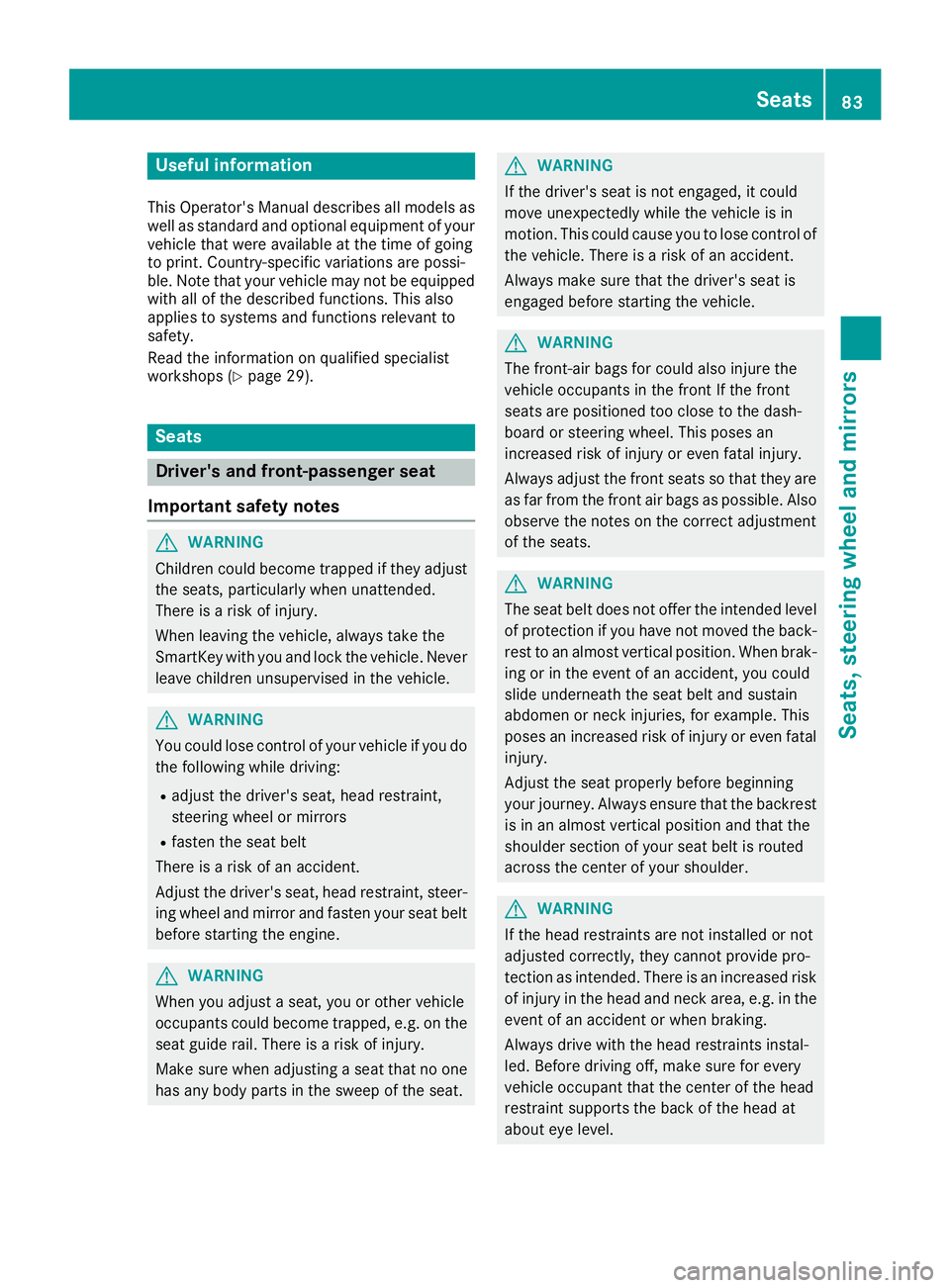
Useful information
This Operator's Manual describes all models as
well as standard and optional equipment of your
vehicle that were available at the time of going
to print.Country-specific variation sare possi-
ble. Note that your vehicle may not be equipped
with all of the described functions. This also
applies to system sand function srelevantt o
safety.
Read the information on qualified specialist
workshops (
Ypage 29).
Seats
Driver' sand front-passenger seat
Important safetyn otes
GWARNING
Children could become trapped if they adjust
the seats, particularly when unattended.
There is arisk of injury.
When leaving the vehicle, always tak ethe
SmartKey with you and lock the vehicle. Never
leave children unsupervised in the vehicle.
GWARNING
You could lose contro lofyour vehicle if you do
the following while driving:
Radjust the driver'ss eat, head restraint,
steering wheel or mirrors
Rfaste nthe seat belt
There is arisk of an accident.
Adjust the driver'ss eat, head restraint,steer-
ing wheel and mirrora nd fastenyour seat belt
before starting the engine.
GWARNING
When you adjust aseat, you or other vehicle
occupants could become trapped, e.g. on the seat guide rail. There is arisk of injury.
Make sure when adjusting aseat that no one
has any body parts in the sweep of the seat.
GWARNING
If the driver'ss eat is not engaged, it could
move unexpectedly while the vehicle is in
motion. This could cause you to lose contro lof
the vehicle. There is arisk of an accident.
Always make sure that the driver'ss eat is
engaged before starting the vehicle.
GWARNING
The front-air bags for could also injure the
vehicle occupants in the frontIft he front
seats are positioned too close to the dash-
board or steering wheel. This poses an
increased risk of injury or even fatal injury.
Always adjust the fronts eats so that they are
as far from the fronta ir bags as possible. Also
observet he notes on the correct adjustment
of the seats.
GWARNING
The seat belt does not offer the intended level of protection if you have not moved the back-
rest to an almost vertical position .When brak-
ing or in the eventofana ccident, you could
slide underneath the seat belt and sustain
abdomen or nec kinjuries, for example. This
poses an increased risk of injury or even fatal injury.
Adjust the seat properly before beginning
your journey. Always ensure that the backrest
is in an almost vertical position and that the
shoulder section of your seat belt is routed
across the center of your shoulder.
GWARNING
If the head restraint sare not installed or not
adjusted correctly, they cannot provide pro-
tection as intended. There is an increased risk
of injury in the head and nec karea, e.g. in the
eventofana ccidentorwhen braking.
Always drive with the head restraint sinstal-
led. Befored rivingoff, make sure for every
vehicle occupant that the center of the head
restraint supportst he back of the head at
about eye level.
Seats83
Seats, steering wheel and mirrors
Z
Page 86 of 310
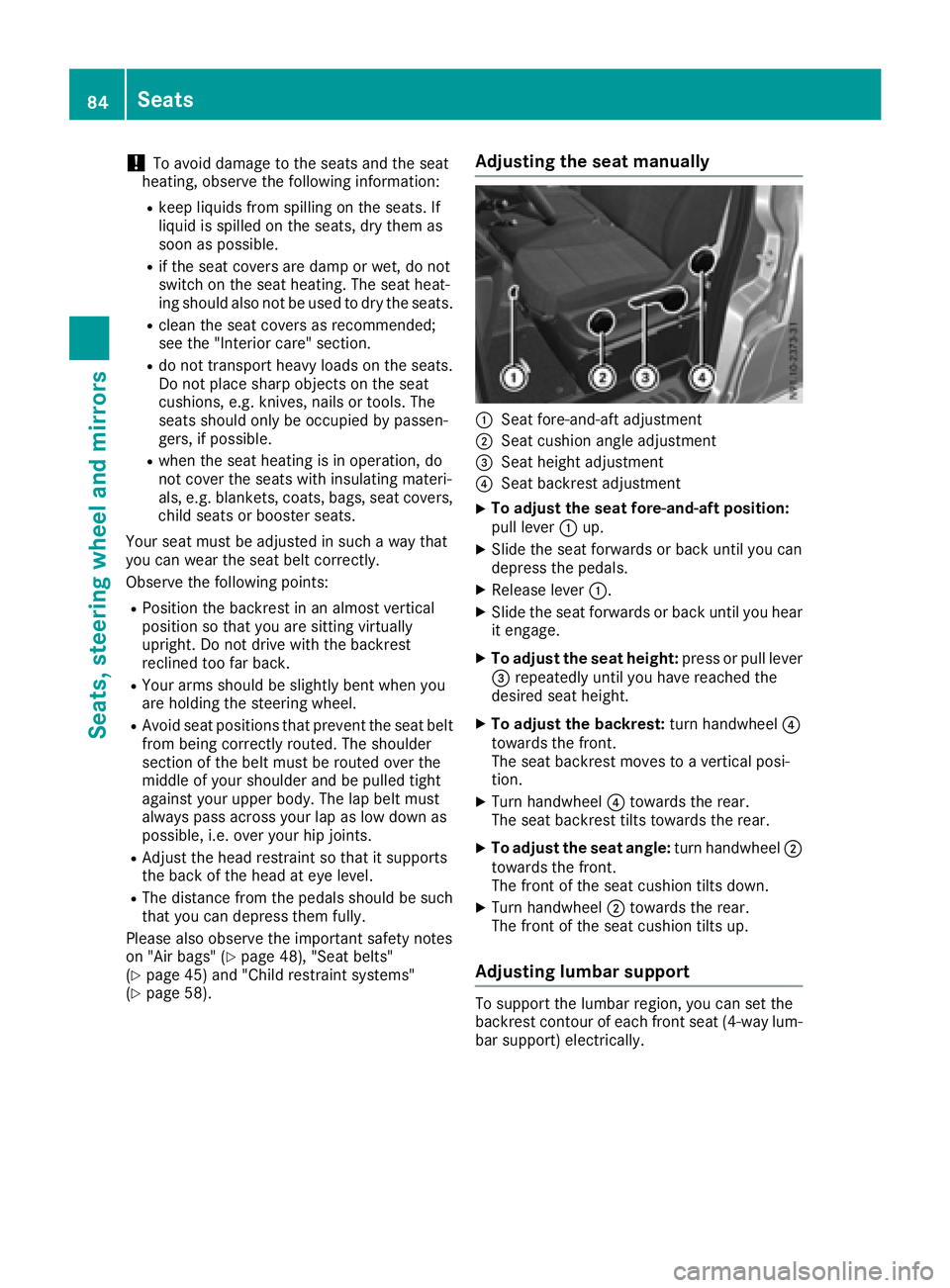
!To avoid damage to the seats and the seat
heating, observe the following information:
Rkeep liquids from spilling on the seats. If
liquid is spilledont he seats, dry them as
soon as possible.
Rif the seat covers are damp or wet, do not
switch on the seat heating. The seat heat-
ing should also not be used to dry the seats.
Rclean the seat covers as recommended;
see the "Interior care" section.
Rdo not transport heavy loads on the seats.
Do not place sharp objects on the seat
cushions, e.g. knives, nails or tools. The
seats should only be occupied by passen-
gers, if possible.
Rwhen the seat heating is in operation, do
not cover the seats with insulating materi-
als, e.g. blankets, coats, bags, seat covers,
child seats or booster seats.
Your seat must be adjusted in such away that
you can wear the seat belt correctly.
Observe the following points:
RPosition the backrest in an almost vertical
position so that you are sitting virtually
upright. Do not drive with the backrest
reclined too far back.
RYour arms should be slightly bent when you
are holding the steering wheel.
RAvoid seat positions that prevent the seat belt
from being correctly routed. The shoulder
section of the belt must be routed over the
middle of your shouldera nd be pulled tight
against your upper body. The lap belt must
always pass across your lap as low down as
possible,i .e. over your hip joints.
RAdjust the head restraint so that it supports
the back of the head at eye level.
RThe distance from the pedalss hould be such
that you can depress them fully.
Please also observe the important safety notes
on "Air bags" (
Ypage 48), "Seat belts"
(Ypage 45) and "Child restraint systems"
(Ypage 58).
Adjusting the seat manually
:Seat fore-and-aft adjustment
;Seat cushion angle adjustment
=Seat height adjustment
?Seat backrest adjustment
XTo adjust the seat fore-and-aft position:
pull lever :up.
XSlide the seat forwards or back until you can
depress the pedals.
XRelease lever :.
XSlide the seat forwards or back until you hear
it engage.
XTo adjust the seat height: press or pull lever
= repeatedly until you have reached the
desired seat height.
XTo adjust the backrest: turn handwheel?
towards the front.
The seat backrest moves to avertical posi-
tion.
XTurn handwheel ?towards the rear.
The seat backrest tilts towards the rear.
XTo adjust the seat angle: turn handwheel;
towards the front.
The front of the seat cushion tilts down.
XTurn handwheel ;towards the rear.
The front of the seat cushion tilts up.
Adjusting lumbar support
To support the lumbarr egion, you can set the
backrest contour of each front seat (4-way lum-
bar support) electrically.
84Seats
Seats, steering whee land mirrors
Page 87 of 310
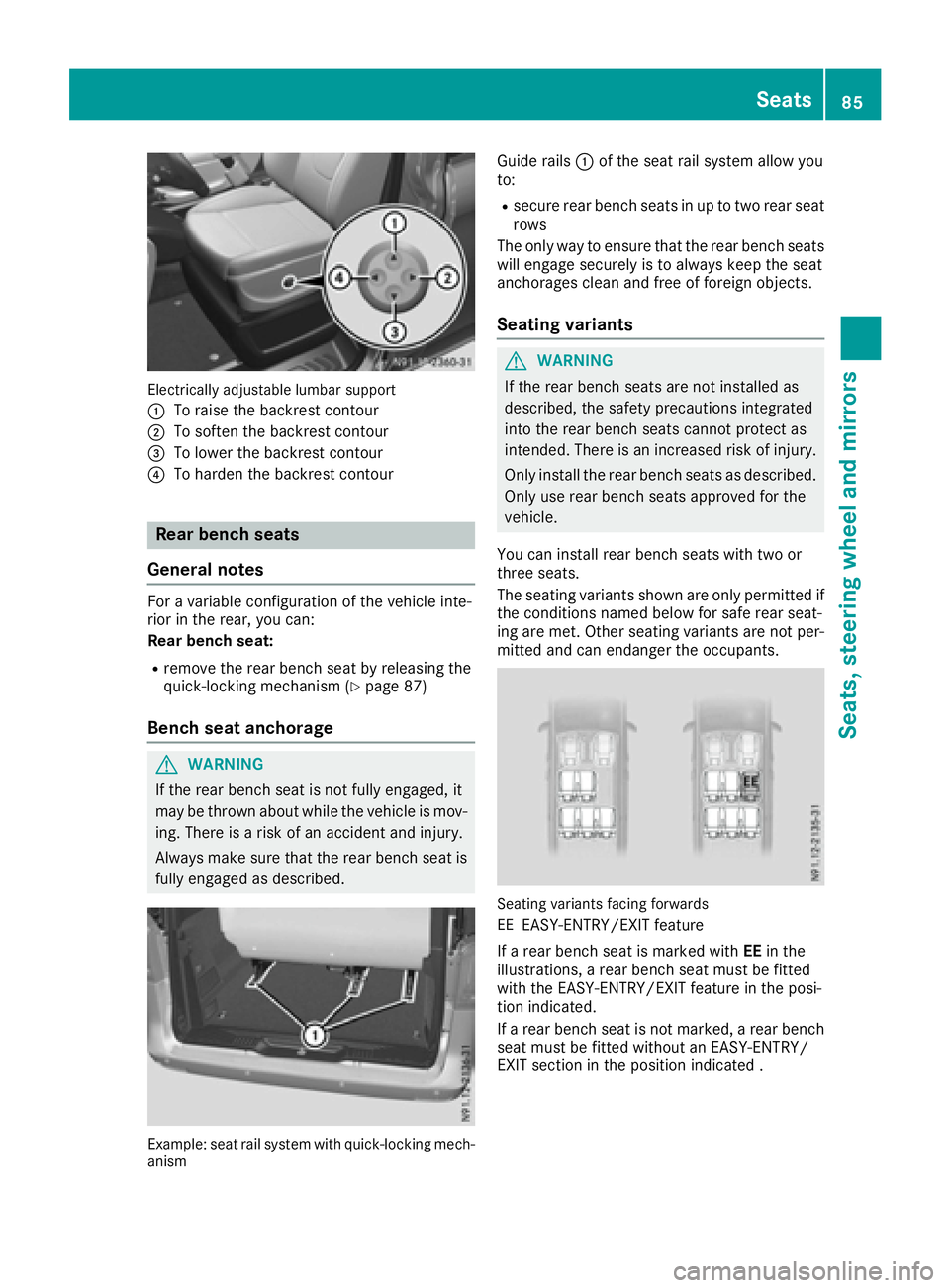
Electrically adjustable lumbarsuppo rt
:
To rais ethe backres tcontour
;To soften the backres tcontour
=To lowe rthe backres tcontour
?To harde nthe backres tcontour
Rear benchs eats
General notes
For avariabl econfiguratio nofthe vehicl einte-
rio rint he rear, yo ucan:
Rea rbench seat:
Rremove the rea rbench sea tbyreleasing the
quick-locking mechanism (Ypage 87)
Bench seat anchorage
GWARNING
If the rea rbench sea tisn ot full yengaged ,it
maybet hrown aboutw hilethe vehicl eismov-
ing .There is ariskofana ccident and injury.
Alway smakes uret hatt he rea rbench sea tis
full yengaged as described.
Example: sea trails ys tem with quick-locking mech-
anism
Guid erails :of the sea trails ystem allo wyou
to:
Rsecur erearb ench seats in up to two rea rseat
rows
The onl ywayto ensure thatt he rearbench seats
will engag esecurel yistoa lwayskeept he seat
anchoragesc lean and freeoff oreignobjects.
Seatin gvariants
GWARNING
If the rea rbench seats ar enot installe das
described, the safety precautions integrated
into the rea rbench seats canno tprotect as
intended. There is an increased ris kofinjury.
Onlyi nstallthe rea rbench seats as described.
Onlyu serea rbench seats approved for the
vehicle.
Yo uc an instal lrea rb ench seats with two or
threes eats.
The seating variants shown ar eonlyp ermitted if
the conditions named belo wfor safe rea rseat-
ing ar emet. Othe rseating variants ar enot per-
mitte dand can endanger the occupants.
Seating variants facing forwards
EE
EASY-ENTRY/EXIT feature
If ar earb ench sea tism arked with EEin the
illustrations, arearb ench sea tmustbef itted
with the EASY-ENTRY/EXIT featur einthe posi-
tio nindicated.
If ar earb ench sea tisn ot marked ,arearb ench
sea tmustbef ittedw ithou tanE ASY-ENTRY/
EXIT sectio ninthe positio nindicated .
Seats85
Seats, steering wheel andmirrors
Z
Page 88 of 310
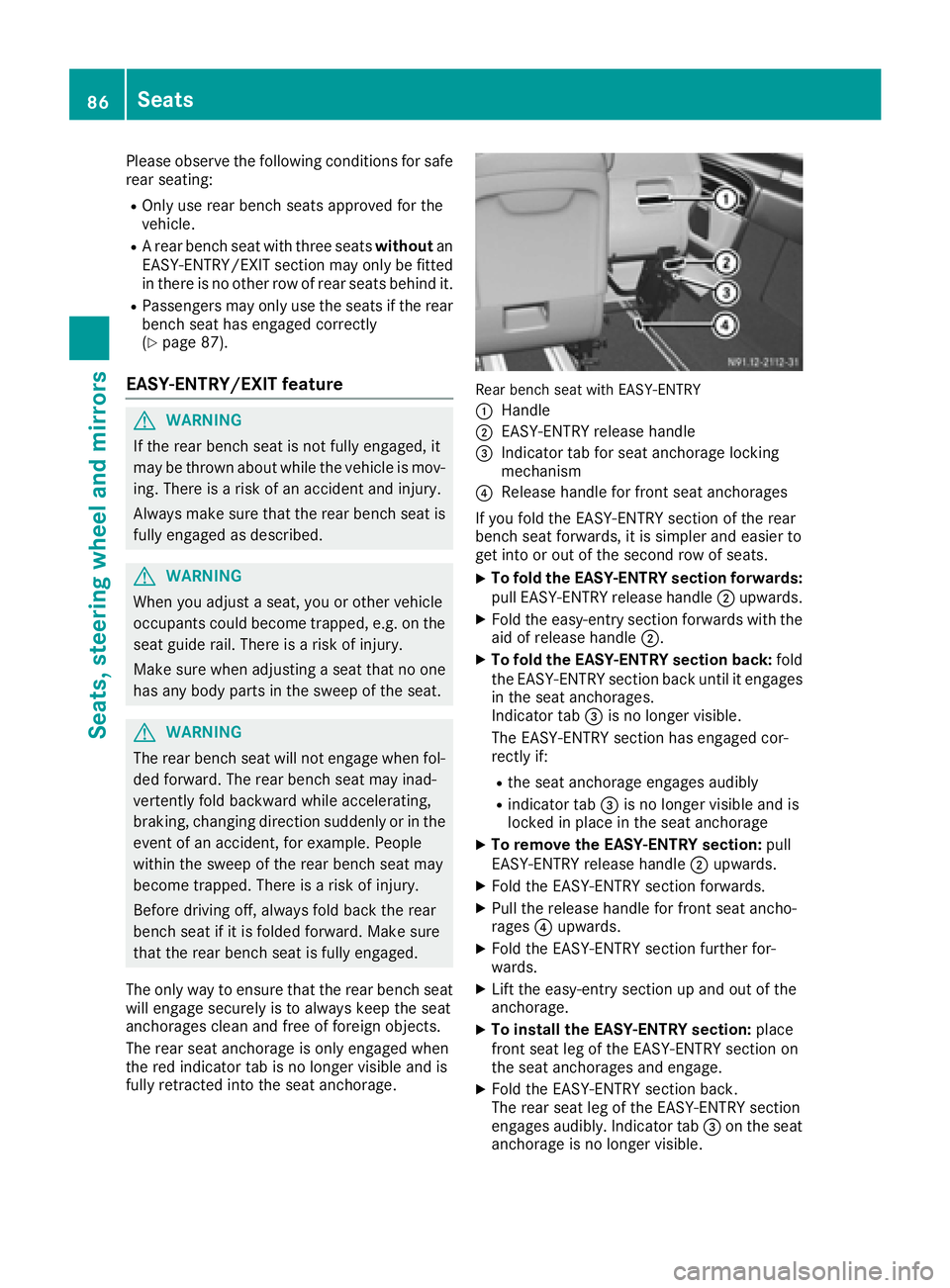
Please observe the following conditions for safe
rear seating:
ROnly use rear bench seats approved for the
vehicle.
RArear bench seat with three seats withoutan
EASY-ENTRY/EXIT section may only be fitted
in there is no other row of rear seats behind it.
RPassengers may only use the seats if the rear
bench seat has engaged correctly
(
Ypage 87).
EASY-ENTRY/EXIT feature
GWARNING
If the rear bench seat is not fully engaged, it
may be thrown about while the vehicle is mov-
ing. There is arisk of an accident and injury.
Always make sure that the rear bench seat is
fully engaged as described.
GWARNING
When you adjust aseat, you or other vehicle
occupantsc ould become trapped, e.g. on the
seat guide rail. There is arisk of injury.
Make sure when adjusting aseat that no one
has any body parts in the sweep of the seat.
GWARNING
The rear bench seat will not engage when fol-
ded forward. The rear bench seat may inad-
vertently fold backward while accelerating,
braking, changin gdirection suddenly or in the
event of an accident ,for example. People
within the sweep of the rear bench seat may
become trapped. There is arisk of injury.
Before driving off, alwaysf old back the rear
bench seat if it is folded forward. Make sure
that the rear bench seat is fully engaged.
The only way to ensure that the rear bench seat
will engage securely is to alwaysk eep the seat
anchorages clean and free of foreign objects.
The rear seat anchorage is only engaged when
the red indicator tab is no longer visible and is
fully retracted into the seat anchorage.
Rear bench seat with EASY-ENTRY
:
Handle
;EASY-ENTRY release handle
=Indicator tab for seat anchorage locking
mechanism
?Release handle for fronts eat anchorages
If you fold the EASY-ENTRY section of the rear
bench seat forwards, it is simpler and easier to
get into or out of the second row of seats.
XTo fold the EASY-ENTRY section forwards:
pull EASY-ENTRY release handle ;upwards.
XFold the easy-entr ysection forwards with the
aid of release handle ;.
XTo fold the EASY-ENTRY section back: fold
the EASY-ENTRY section back until it engages
in the seat anchorages.
Indicator tab =is no longer visible.
The EASY-ENTRY section has engaged cor-
rectly if:
Rthe seat anchorage engages audibly
Rindicator tab =is no longer visible and is
locked in place in the seat anchorage
XTo remove the EASY-ENTRY section: pull
EASY-ENTRY release handle ;upwards.
XFold the EASY-ENTRY section forwards.
XPull the release handle for fronts eat ancho-
rages ?upwards.
XFold the EASY-ENTRY section further for-
wards.
XLift the easy-entr ysection up and out of the
anchorage.
XTo install the EASY-ENTRY section: place
fronts eat leg of the EASY-ENTRY section on
the seat anchorages and engage.
XFold the EASY-ENTRY section back.
The rear seat leg of the EASY-ENTRY section
engages audibly.I ndicator tab=on the seat
anchorage is no longer visible.
86Seats
Seats, steering wheel and mirrors
Page 89 of 310
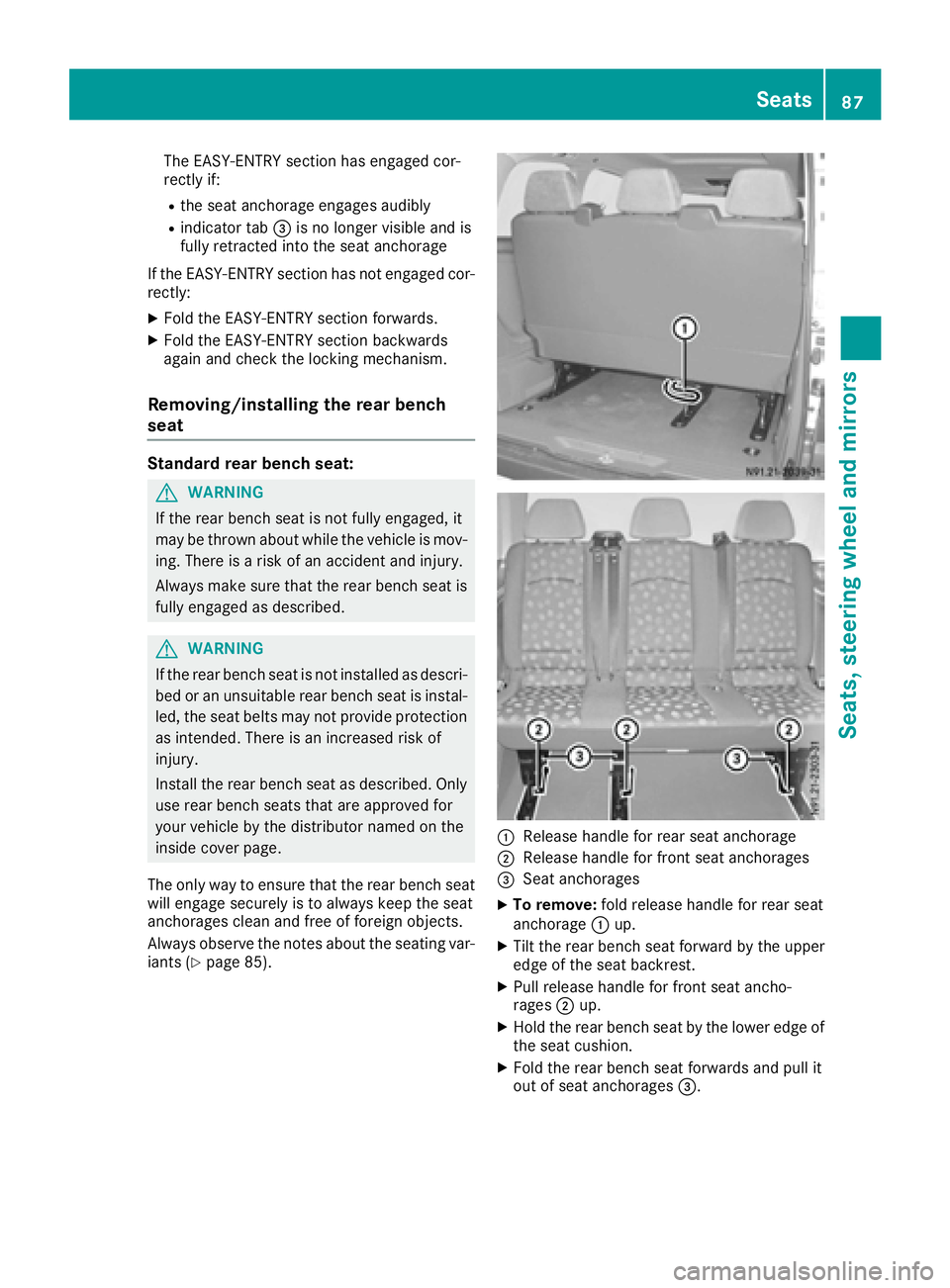
The EASY-ENTRY section has engaged cor-
rectly if:
Rthe seat anchorage engages audibly
Rindicator tab=is no longer visible and is
fully retracted into the seat anchorage
If the EASY-ENTRY section has not engaged cor-
rectly:
XFold the EASY-ENTRY section forwards.
XFold the EASY-ENTRY section backwards
again and check the lockingm echanism.
Removing/installing the rear bench
seat
Standard rear bench seat:
GWARNING
If the rear bench seat is not fully engaged, it
may be thrown about while the vehicle is mov-
ing. There is arisk of an accident and injury.
Always make sure that the rear bench seat is
fully engaged as described.
GWARNING
If the rear bench seat is not installed as descri- bed or an unsuitable rear bench seat is instal-
led, the seat belts may not provide protection
as intended. There is an increased risk of
injury.
Install the rear bench seat as described. Only
use rear bench seats that are approved for
your vehicle by the distributor named on the
inside cover page.
The only way to ensure that the rear bench seat
will engage securely is to alwaysk eep the seat
anchorages clean and free of foreign objects.
Always observe the notes about the seating var-
iants (
Ypage 85).
:Release handle for rear seat anchorage
;Release handle for front seat anchorages
=Seat anchorages
XTo remove: fold release handle for rear seat
anchorage :up.
XTilt the rear bench seat forward by the upper
edge of the seat backrest.
XPull release handle for front seat ancho-
rages ;up.
XHold the rear bench seat by the lower edge of
the seat cushion.
XFold the rear bench seat forwards and pull it
out of seat anchorages =.
Seats87
Seats, steering wheel and mirrors
Z
Page 90 of 310
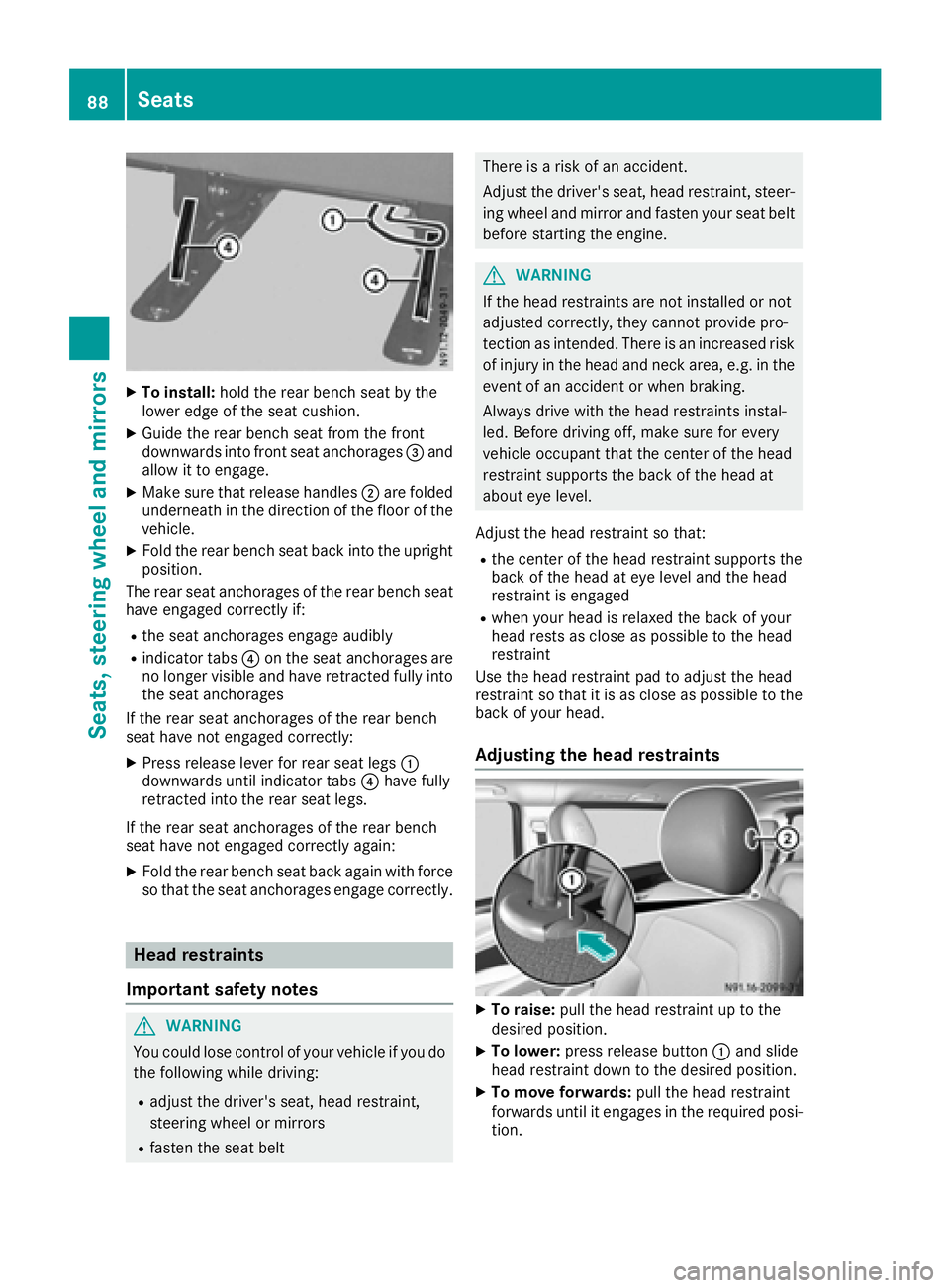
XTo install:holdthe rea rbench sea tbythe
lowe redgeoft he sea tcushion.
XGuid ethe rea rbench sea tfrom the front
downward sinto front sea tanchorages =and
allo wittoe ngage.
XMake sure thatr elease handles;are folded
underneath in the direction of the floor of the
vehicle.
XFol dthe rea rbench sea tbackinto the upright
position.
The rea rseata nchorages of the rea rbench seat
have engaged correctl yif:
Rthe sea tanchorages engage audibly
Rindicator tabs ?on the sea tanchorages are
no longer visible and have retracted fully into
the sea tanchorages
If the rea rseata nchorages of the rea rbench
sea thaven ot engaged correctly:
XPress release lever for rea rseatleg s:
downward suntilindicator tabs ?have fully
retracted into the rea rseatleg s.
If the rea rseata nchorages of the rea rbench
sea thaven ot engaged correctl yagain :
XFoldthe rea rbench sea tbacka gain with force
so thatt he seatanchorages engage correctly.
Hea drestraints
Important safety notes
GWARNING
Yo uc ould lose contro lofyourvehicl eifyoudo
the following whil edriving:
Radjus tthe driver's seat, hea drestraint,
steering whee lormirrors
Rfasten the sea tbelt
There is ariskofana ccident.
Adjust the driver' sseat, hea drestraint, steer-
ing whee land mirror and fasten your sea tbelt
before starting the engine.
GWARNING
If the hea drestraints are not installe dornot
adjusted correctly, they canno tprovid epro-
tection as intended. There is an increased risk
of injury in the hea dand neck area, e.g .inthe
event of an accident or when braking.
Alway sdrive with the hea drestraints instal-
led. Before driving off, make sure for every
vehicl eoccupant thatt he centerofthe head
restraint supports the back of the hea dat
aboute yelevel.
Adjust the hea drestraint so that:
Rthe cente rofthe hea drestraint supports the
back of the hea dateyelevel and the head
restraint is engaged
Rwhen your hea disrelaxe dthe back of your
hea drests as close as possibl etothe head
restraint
Use the hea drestraint pa dtoadjus tthe head
restraint so thatiti sasclose as possibl etothe
back of your head.
Adjustin gthe hea drestraints
XTo raise: pull the hea drestraint up to the
desired position.
XTo lower: press release button :and slide
hea drestraint down to the desired position.
XTo mov eforwards: pull the hea drestraint
forward suntilite ngages in the required posi-
tion.
88Seats
Seats, steering wheel andmirrors